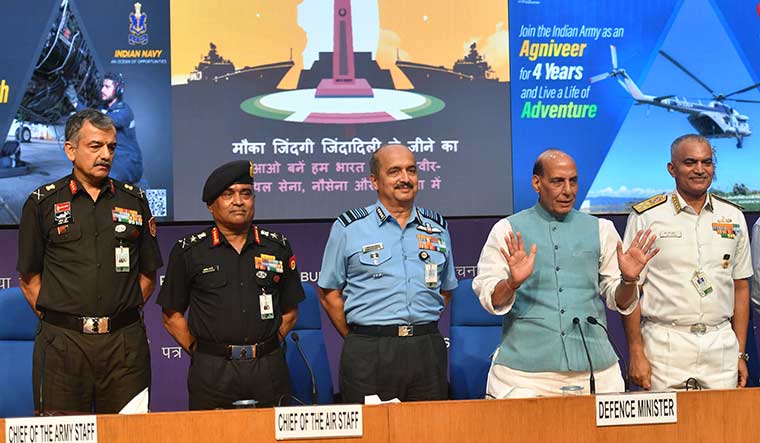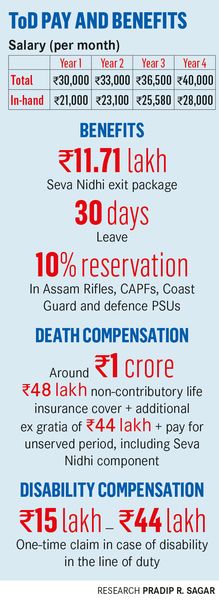The Indian military has been fighting four enemies—the Chinese and the Pakistanis outside; and an ageing soldiery, and rising pay and pension bills within. To tackle the latter two, on June 14, the government announced the Agnipath scheme, or tour of duty. Under this, youth would be recruited between the ages of 17 and a half and 21, be trained for six months and be allowed to serve anywhere from Siachen to Secunderabad. After four years, though, three-fourth of them would be packed off with cheques for 011.71 lakh each, and whatever balance they had saved from their pay. Once out of the Army, they would not get any of the perks today’s veterans get.
Hardly had the ministry made the announcement when all hell broke loose. Thousands of boys who had been cleared in physical and medical tests and had been waiting for the military’s call for the past two Covid years (when no recruitment took place) gave vent to their frustration on the streets. And veterans, even those who wore star ranks, denounced the scheme or suggested improvements.
The government quickly moved to pacify the first group. A two-year relaxation of the upper age limit was announced for those who missed the call in the past two years. The government also promised quotas for demobbed Agniveers in the paramilitary and in civil jobs in the defence ministry and its PSUs. The offers clicked; protests died down. The veterans, however, are still divided over the efficacy of the scheme.
Actually, there is nothing new in the Agnipath idea, except the nomenclature. The soldier has been ageing ever since the military extended colour service in the 1970s. The problem got aggravated in the early 1990s when those recruited in the 1970s were still found to be serving at 37 and 38, bringing the average age to above 30. “The Kargil Review Committee and the Arun Singh Committee had raised objections on the average age of soldiers, which was in the 30s, during the Kargil war; it is 32 currently,” said Lt Gen Anil Puri, additional secretary in the department of military affairs.
The pension bill, too, had been mounting, and the Modi government’s move to implement the long-deferred one-rank-one-pension promise sent it shooting up to more than a fourth of the total defence ministry spend.
The solutions now being offered are also old, and some of them were ignored by several expert committees. For instance, though the K. Subrahmanyam committee—which studied the national security apparatus after the Kargil war—had recommended that soldiers be demobbed after five years of service and be absorbed into the paramilitary, the L.K. Advani-led Group of Ministers that reviewed the recommendations found that the paramilitary was not willing to take the ex-soldiers. Several parliamentary committees that have looked into this suggestion have also reported the same.
The primary reason is that the paramilitary’s training and operational philosophy are radically different from the Army’s. “The soldier in the Army fights the external enemy; he is trained to kill,” explained a senior defence ministry officer. “He uses anything from a bayonet to a ballistic missile. The paramilitary’s primary weapon is the rifle; his operational training is to overpower the enemy and bring him to the law. It takes a lot to convert the Army sepoy or naik into a constable.”
The Agnipath scheme will also abolish the British Raj system of recruiting soldiers based on caste, religion, region and martial race, which has been in practice since Lord Roberts introduced it in the late 19th century. Currently, 70 per cent of the soldiers come from 168 out of 775 districts, most of them in the north. Agniveers, on the other hand, will be inducted based on an all-India, all-class basis, and posted into any battalion or regiment.
The idea is to recruit 46,000 young men in the first year, through 83 recruitment rallies to be held from August to November. The Army, which will get a major chunk of them, expects to receive the first batch by December, and get them in the units after training by next July. There is no change in the process of induction, entry-level qualification, examination syllabus or medical standards. The Agniveer, however, will wear a distinctive insignia on his uniform. The Agniveer will be eligible for all the gallantry honours like the regular troops, and also perks such as the Siachen allowance.
All the same, most aspirants and even veterans are not convinced that the scheme will work well. “If I want to join the paramilitary or police or Assam Rifles, I can directly join them,” said 18-year-old Samarth Kumar, who hails from a village of veterans in Haryana’s Jind district. “That would also assure me a job till 55 or more, with full pay, pension and other perks. Why should I waste my first four years in the Army?”
Within the Army, too, there are concerns. If the regular trooper today is trained in basics like weapon handling and fieldcraft for 44 weeks, the Agniveer will receive only 26 weeks of training. “I have my doubts whether this is enough,” said a serving major-general. “The basic training, which is about weapons and military things, will hardly equip him for civil life. All the special skills that we impart to the soldier are done in the units.”
Which means, even the so-called tech skills that should earn the Agniveer credits for his demobbed life are unlikely to come by in the six months training. “Repairing of aircraft, ships or radars, sonars, communication equipment etc are given on the job. These often take years. You cannot expect the Agniveer to be trained in these skills in six months,” said the major-general.
As a colonel who is commanding an armoured regiment pointed out, “A recruit joining the Armoured Corps has to undergo about five months of basic training.... The young soldiers reach the regiments after nearly a year and a half from the day they get into uniform. Will this will be brought down to six months?”
However, Lt Gen J.S. Sandhu, former military secretary, allays such fears. “In most armies of the world, soldiers serve up to two or three years,” he said. “In today’s time, with one week of training, a person can handle drones. Ukrainian soldiers are firing missiles at Russian aircraft and tanks. The young soldier who has joined the service last year is doing this. Some worries will be there on maintenance of equipment, but the regular people can take care of it.”
A more serious concern is the question of trust. “There are several technical matters about aircraft maintenance and even gunnery skills that are classified. Would a CO (commanding officer) trust a fresher who will leave the service after a few months with these things?” wondered the major-general. “It costs a few thousand to fire a shell. Would the CO like to spend a few dozen shells to train a guy who he knows will leave in the next few months?”
There are also those who fear that demobbed Agniveers could be targets of espionage. “Someone at the age of 25 is attracted to money or may be honey-trapped. A soldier with 20 years of service with kids will be overcautious.”
Also, the Army spends about Rs16 lakh to train a soldier, the navy Rs27 lakh on a sailor and the Air Force Rs39 lakh on an airman. “If the man is going to leave the service after four years, are we getting the value for the money we spent on him?” asked the major-general.
There is also criticism that the scheme has not been properly thought out or discussed. The ministry has not cited any committee or paper that has laid out the scheme, except broad recommendations that had been made and rejected by earlier committees. But the ministry denies this. “The services held 150 meetings of over 500 hours, while the ministry of defence had 60 meetings of 150 hours to work out the modalities of the scheme for the past two years,” said Lt Gen Puri. “The whole government, including all stakeholders, had 44 rounds of meeting in which 100 hours of discussions have taken place.”
There has, however, been little discussion outside. “The scheme can have more fallouts in the society than in the military,” said a BJP MP. “When you unleash several thousand arms-trained young men without jobs into the society, you should prepare the society. Sending a man into the Army is a matter of prestige in most north-Indian villages. With good pay, travel facilities, medical facilities, pension and even widow pension etc, an entire family is suddenly offered lifetime security. Let’s admit it, it even enhances his value in the marriage market. Now, what happens to the family, and even to the man’s self-esteem when he comes back after four years without even a job?” He said the scheme should have been discussed in parliamentary committees and also think tanks to assess the socio-economic fallout.
While everyone agrees that the Agnipath scheme will cut costs and improve the age profile of the military, many experts are worried whether it will also cut its fighting skill and spirit. “An under-trained soldier may put everyone’s life in danger,” said Lt Gen Vinod Bhatia, former director-general of military operations. A minor violation of the drill can alert the enemy, especially during night patrol, and endanger the lives of all others.
But more important is the question of military spirit and ethos. The military, especially the Army, puts a lot of premium on values like man-to-man bonding, honour and traditions of the battalion and the regiment, bonding between the commanding officer and the troops and so on. “Such values are imbibed over several years of training together, living together, working together and fighting together,” pointed out an officer. “It is these values that make even the battle-hardened troops implicitly obey the commands of the young officers fresh from the academy. We are an Army of officers who lead from the front, and that has made us the finest Army in the world. What we lack in terms of technology and weaponry, we make up with fighting spirit.”
As commanding officers have been pointing out, the soldier essentially fights for naam, namak and nishaan—values that have been engrained in the soldierly mind over decades of combat and sacrifice.
—With inputs from R. Prasannan




